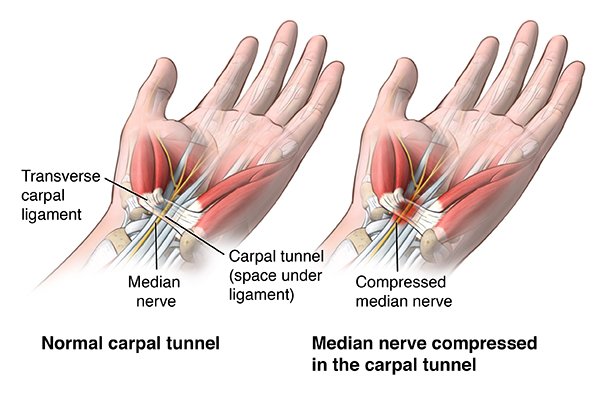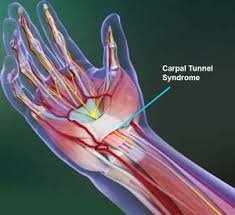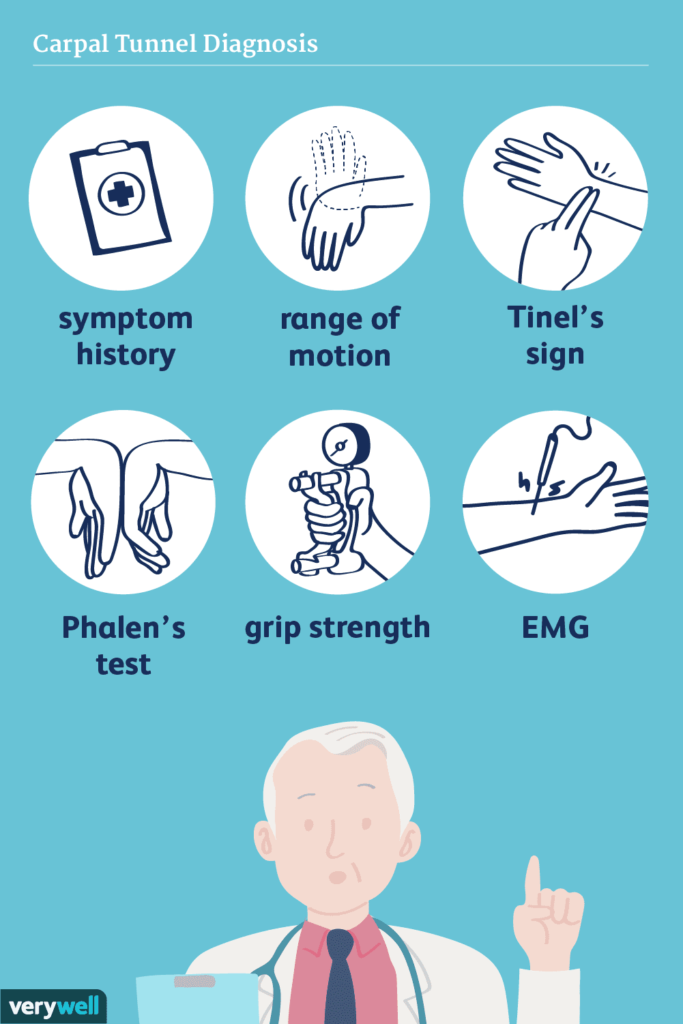Carpal Tunnel Syndrome (CTS) is a medical condition that occurs when the median nerve, which runs from the forearm into the hand through a narrow passageway in the wrist called the carpal tunnel, is compressed or pinched, leading to numbness, tingling, and pain in the hand and wrist.

Reference: CTS
Anatomy
The carpal tunnel is a narrow, tube-like structure in the wrist that contains:
Median Nerve
The nerve that carries sensory and motor signals between the hand and forearm.
Tendons
Nine tendons that connect muscles in the forearm to bones in the hand.
Carpal Bones
A small group of eight bones that form the wrist’s bony framework, enabling smooth movement and flexibility.
Ligaments
Fibrous tissues that connect bones and hold the tunnel in place.
When the median nerve is compressed or pinched within the carpal tunnel, it can cause the symptoms of CTS.
Causes and Risk Factors
Causes:
- Repetitive Strain: Performing repetitive tasks, such as typing, assembly line work, or using vibrating tools, can cause strain on the wrist and lead to CTS.
- Poor Wrist Alignment: Bending or twisting the wrist in an awkward position can put pressure on the median nerve and cause CTS.
- Fluid Retention: Swelling in the wrist due to pregnancy, menopause, or medical conditions can compress the median nerve and lead to CTS.
- Nerve Compression: Compression of the median nerve by surrounding tissues or bone can cause CTS.
- Trauma: Wrist injury or fracture can cause CTS by damaging the median nerve or surrounding tissues.
- Medical Conditions: Certain medical conditions, such as diabetes, arthritis, and thyroid disorders, can increase the risk of developing CTS.
Risk Factors:
1. Occupation: Jobs involving repetitive tasks, vibration, or forceful gripping increase the risk of CTS.
2. Age: The risk of developing Carpal Tunnel Syndrome tends to rise significantly after the age of 40, with the majority of cases typically occurring in individuals around the age of 50.
3. Gender: Women are 3-4 times more likely to develop CTS than men.
4. Family History: Having a family member with CTS increases the risk.
5. Obesity: Excess weight can lead to fluid retention and increased pressure on the median nerve.
6. Smoking: Smoking can reduce blood flow to the median nerve and increase the risk of CTS.
7. Pregnancy and Menopause: Hormonal changes and fluid retention during pregnancy and menopause can increase the risk of CTS.
8. Medical Conditions: Certain medical conditions, such as diabetes, arthritis, and thyroid disorders, can increase the risk of developing CTS.
These causes and risk factors can contribute to the development of Carpal Tunnel Syndrome. It’s essential to be aware of these factors to take preventive measures and seek medical attention if symptoms arise.
Symptoms
The symptoms of Carpal Tunnel Syndrome (CTS) can vary, but common experiences include numbness or tingling in the thumb, index, middle, and half of the ring finger, as well as burning or shock-like sensations in the fingers. Pain or aching in the wrist, palm, or fingers is also common, and some people may experience weakness or clumsiness in the hand, making it difficult to grip or hold objects. Additionally, tingling or numbness may worsen at night, disrupting sleep, and some individuals may drop objects due to weakness or numbness in the hand. Fine motor tasks, such as buttoning a shirt or tying a tie, can also become challenging.
Diagnosis
1. Medical History: A doctor will ask questions about symptoms, medical history, and daily activities.
2. Physical Examination: A doctor will perform a physical exam to assess hand and wrist function, sensation, and strength.
3. Tinel’s Sign: A doctor will tap the median nerve to see if it produces a tingling sensation.
4. Phalen’s Test: A doctor will ask the patient to flex their wrist for 60 seconds to see if it produces numbness or tingling.
5. Electromyography (EMG): Measures the electrical activity of muscles to diagnose muscle damage.
6. Nerve Conduction Study (NCS): Measures the speed and strength of electrical signals in the median nerve.
7. Imaging Tests: X-rays, ultrasound, or MRI scans may be used to rule out other conditions or confirm CTS.
Treatment Options
Conservative Treatment Options:
Preservationist treatment choices are as a rule the to begin with line of defense against Carpal Burrow Disorder. These may incorporate rest and ice to decrease swelling, physical treatment to extend and reinforce the wrist and hand, and wrist props to keep the wrist in a impartial position. Solutions such as torment relievers, anti-inflammatory drugs, and corticosteroid infusions may moreover be endorsed to oversee side effects. Also, ergonomic changes to the workspace and exercises can offer assistance decrease strain on the wrist, and elective treatments like needle therapy, knead, and yoga may be suggested to diminish torment and make strides work.
Surgical Treatment Options:
If conservative measures don’t yield the desired results, surgical intervention may be recommended to treat the condition effectively.. Open release surgery involves cutting the ligament to release pressure on middle nerve, whereas endoscopic surgery employments a little camera and surgical disobedient to accomplish the same objective. Mini-open surgery combines elements of both techniques. Carpal tunnel release is the surgical procedure that releases the compressed median nerve.
Post-Surgical Care:
Following surgery, post-surgical care is crucial to ensure proper healing. This may include pain management with medications and ice, wrist immobilization with a splint, gentle physical therapy exercises to promote strength and healing, and a gradual return to normal activities.
Reference: Diagnosis
Prevention and Ergonomics
Prevention
To minimize the risk of Carpal Tunnel Syndrome, it’s essential to cultivate good habits and be mindful of your behavior. This includes maintaining optimal posture, taking regular breaks to stretch and move around, and engaging in exercises that strengthen your wrists and hands. Moreover, using proper lifting techniques, managing your weight, and avoiding smoking can also help prevent the condition.
Ergonomics
Creating a well-designed workspace is crucial for preventing Carpal Tunnel Syndrome. This involves positioning your keyboard and monitor in a way that promotes comfortable typing and viewing, adjusting your chair height to support good posture, and using a wrist rest to reduce strain on your wrists. Additionally, ensuring your tools are well-maintained and properly fitted, and considering alternative mouse options can help create a comfortable working environment.
Complications
If left untreated, Carpal Tunnel Syndrome can lead to complications that impact daily life and work. Prolonged nerve compression can cause permanent nerve damage, resulting in persistent numbness, tingling, and weakness in the hand and wrist. This can lead to decreased hand function, making everyday activities like gripping, grasping, and manipulating objects challenging. In severe cases, untreated Carpal Tunnel Syndrome can cause muscle atrophy, or wasting, in the hand, leading to decreased dexterity and coordination. Furthermore, the condition can also lead to depression, anxiety, and decreased quality of life due to chronic pain and disability.
Prognosis
The prognosis for Carpal Tunnel Syndrome is generally good if treated promptly and properly. With conservative treatments like physical therapy, wrist splints, and medication, most people experience significant improvement in symptoms within a few weeks to months. Surgical intervention can also provide excellent outcomes, with many people experiencing complete relief from symptoms after surgery. However, in some cases, symptoms may persist or recur, requiring ongoing management and treatment. Early detection and treatment are critical to preventing long-term nerve damage and ensuring optimal outcomes. With proper care and management, most people with Carpal Tunnel Syndrome can return to their normal activities and enjoy improved hand function and overall quality of life.
Reference: Anatomy
Carpal Tunnel Syndrome is a prevalent condition that can be effectively managed with timely intervention and proper care. By recognizing the risk factors, symptoms, and treatment options, individuals can take control of their health and wellbeing. With a comprehensive approach that incorporates prevention, treatment, and lifestyle modifications, most people can alleviate their symptoms and regain optimal hand function. Don’t delay seeking medical attention if you’re experiencing persistent discomfort or numbness in your hands or wrists – early action can make a significant difference in achieving a successful outcome and improving your overall quality of life.
Read previous article https://educationforlife.site/shoulder-joint/






